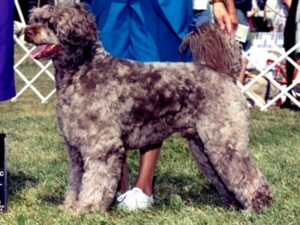
The Portuguese Water Dog
Discover the Portuguese Water Dog breed’s characteristics and how to judge them in this insightful article. Dive into PWD excellence!

Home » Dog Breeds » Portuguese Water Dog Breed
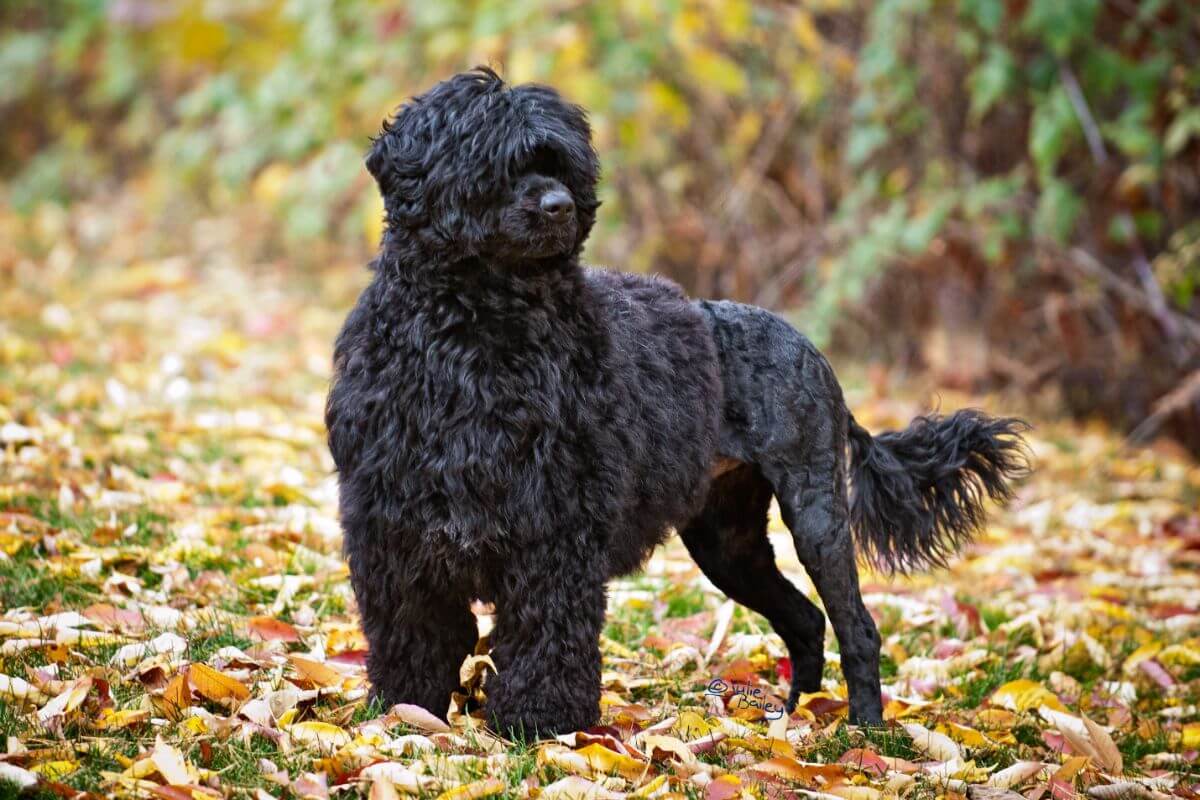
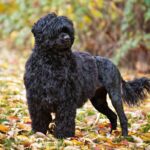
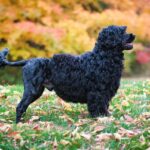
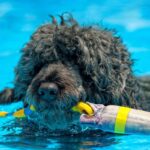
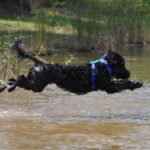
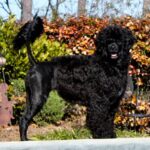
The Portuguese Water Dog, often affectionately called the “Portie,” is a breed notable for its intelligence, spirited disposition, and impressive swimming ability. Originally bred to assist fishermen along Portugal’s coast, these dogs are robust, energetic, and possess a strikingly attractive coat, making them popular both as working dogs and family companions.
Working
17 – 23 inches
35 – 60 pounds
11 – 13 years
| Country of Origin | Portugal |
|---|---|
| Bred For | Herding Fish, Retrieving Nets, Courier, Guard Dog |
| Known For | High Spirit, Intelligence, Loyalty |
| Popularity | Moderate |
| Temperament | Brave, Intelligent, Loyal, Obedient |
| Activities | Swimming, Retrieving, Hiking, Conformation Shows, Dog Sports |
The Portuguese Water Dog dog breed has a rich history rooted in the coastal regions of Portugal. Originating from the Algarve region, these dogs were indispensable companions to fishermen, playing a vital role in the fishing industry.
Their primary role was to herd fish into nets, retrieve lost tackle or broken nets, and act as couriers between ships and shore. Remarkably adaptable and robust, the Portuguese Water Dog was prized for its swimming and diving abilities, which were essential in the daily life of fishing communities.
The exact origins of the breed are somewhat unclear, but they are believed to have descended from working dogs brought to the Iberian Peninsula by the Moors during their occupation in the 8th century. These ancient lineage dogs likely mixed with local Portuguese breeds, giving rise to the Portuguese Water Dog we know today.
With the decline of the fishing industry and the advent of modern fishing techniques in the 20th century, their numbers dwindled alarmingly. By the 1930s, they were nearing extinction. However, efforts by Portuguese businessman and dog enthusiast Vasco Bensaude, along with breeders and fanciers, saved the breed. Bensaude’s breeding program played a pivotal role in revitalizing the Portuguese Water Dog breed, and he is frequently acknowledged for his significant contribution to their survival.
The Portuguese Water Dog breed gained official recognition from the American Kennel Club (AKC) in 1983, a testament to its growing popularity outside Portugal. The Fédération Cynologique Internationale (FCI) and The Kennel Club (UK) also recognize the breed, affirming its international appeal.
Portuguese Water Dog’s remarkable history as a working dog on fishing boats has endowed the breed with unique traits, both in its physical abilities and its temperament. This historical background not only adds to its allure but also highlights the importance of breed preservation and responsible breeding practices.
Adult male Portuguese Water Dogs generally stand between 20 and 23 inches tall at the shoulders, while females are slightly shorter, typically ranging from 17 to 21 inches.
In terms of weight, mature males usually weigh from 42 to 60 pounds, whereas females are generally lighter, weighing between 35 and 50 pounds.
The Portuguese Water Dog is well-proportioned, exhibiting a robust and muscular build that signifies strength and agility. The breed is off-square in proportion, slightly longer than it is tall, with substantial bone and well-muscled hindquarters that are indicative of the breed’s remarkable power in water-based activities.
The substance of the Portuguese Water Dog is substantial, neither coarse nor refined, making an impression that’s powerful rather than elegant. Balance of proportion is indicative of the stamina that ‘s required of a dog originally bred for demanding tasks both in and out of water.
Texture: The Portuguese Water Dog boasts a distinctive coat that is a defining feature of the breed. It is characterized by its profuse, dense nature, which is either wavy or curly. The texture of the coat is critical to the breed’s functionality in water. The curly variety features compact, cylindrical curls with a matte finish, whereas the wavy type displays gentler waves and a slight sheen. The breed’s unique coat texture serves as a protective layer against harsh weather and cold water, reflecting its heritage as a working dog in maritime settings.
| Standard Color | |
|---|---|
| Black | ee |
| Brown | ee |
| White | ee |
A Note About Color: The coat of the Portuguese Water Dog is a hallmark of the breed. It may be either curly or wavy and is clipped in one of two styles; lion clip or retriever clip. A dog with a lion will have its muzzle, middle part of the body, and hindquarters clippered short, leaving a tuft on the end of the tail. A dog with a retriever clip will have its entire coat trimmed to a length of one inch, leaving the coat on the end of the tail at full length. Porties may be black or brown in color, with or without white and/or ticking, or white of various intensities. Albino, black and tan, brindle, sable, and tri-colored coats are unacceptable.
| Standard Marking | |
|---|---|
| White Markings | ee |
The tail of the Portuguese Water Dog is another significant aspect of its morphology, as it is an essential tool for swimming, acting as a rudder. It is set slightly below the level of the back and never docked. The tail’s thickness is medium and tapers towards the tip.
When the dog is alert or in motion, the tail is carried in a ring but should not reach forward of the loin. At rest, the tail’s carriage is typically relaxed, dropping down in a slight curve. In a breed known for its lively disposition and agility, the tail’s movement often reflects the dog’s emotional state and level of excitement or alertness.
Owning a Portuguese Water Dog offers a unique and fulfilling experience, marked by the breed’s energetic and affectionate nature. Known for their intelligence and loyalty, Portuguese Water Dogs create strong bonds with their families, often becoming an integral and interactive member of the household. However, potential owners should consider certain factors to make sure that they can provide the best care and environment for these active and spirited dogs.
Portuguese Water Dogs are generally robust and healthy, but like all breeds, they have specific health considerations that prospective owners should be aware of. Their athletic build and active lifestyle mean they require regular exercise and mental stimulation to maintain their health and happiness.
The average lifespan of a Portuguese Water Dog ranges from 11 to 13 years. This breed, being hardy and well-constituted, often enjoys a full, vibrant life. Nonetheless, awareness and proactive management of certain health conditions can significantly contribute to their overall well-being and longevity. Caretakers should be prepared for regular health check-ups and be attentive to any signs of potential health issues that are known to affect this breed.
The Portuguese Water Dog, like any breed and mixed breed, has certain health risks that prospective caretakers should be aware of. Regular veterinary check-ups and a keen awareness of these conditions can help in early detection and management. Common health issues in this breed include:
Routine veterinary check-ups are essential to maintaining the health of a Portuguese Water Dog. These appointments provide an opportunity for early detection and management of any health issues, helping the dog to live a long, healthy, and happy life.
The personality of the Portuguese Water Dog is characterized by a blend of intelligence, enthusiasm, and affection. These dogs are highly social and thrive on interaction with their human companions, making them a wonderful addition to active households. Their temperament is well-suited to both experienced handlers and those newer to dog ownership, provided they are ready to engage with the breed’s energy and intelligence.
Portuguese Water Dogs possess a moderate sensitivity level. They respond well to positive reinforcement and are keen to please their humans, which can make training a rewarding experience. However, their sensitivity also means they can react to the tone of voice and mood of their surroundings, so a positive, consistent approach in training and interaction is beneficial.
While they can manage short periods on their own, they prefer company and can become anxious if left alone for extended periods. Early training to help them become comfortable with alone time is essential to prevent separation anxiety.
When it comes to other dogs and young children, Portuguese Water Dogs are generally friendly and adaptable. They are playful and patient, which makes them good companions for children, though interactions should always be supervised, especially with younger kids. Their sociability extends to other dogs as well, and they often enjoy playdates and social interactions with other canines.
Their friendly demeanor usually extends to strangers as well, though they can be initially reserved. Early socialization is key to making sure that they are comfortable and confident in a variety of situations and with different people.
Overall, the Portuguese Water Dog is a loyal, affectionate, and intelligent breed that fits well into a variety of home environments. Their adaptable and friendly nature, combined with their intelligence and eagerness to learn, makes them a delightful companion for those who can keep up with their active lifestyle.
Proper feeding and nutrition are crucial for maintaining the health and vitality of a Portuguese Water Dog. The dietary needs of these dogs vary depending on their age, size, metabolism, and activity level. It’s essential to tailor their diet to suit their individual needs, guaranteeing that they receive the right balance of nutrients.
For puppies, a high-quality puppy formula that’s specifically designed to support their rapid growth and development is important. Puppies should be fed more frequently—usually three to four times a day—to sustain their energy levels and aid in healthy growth. As they transition into adulthood, the frequency of meals can be reduced to twice a day.
Adult Portuguese Water Dogs generally require a balanced diet rich in protein to support their active lifestyle. The amount of food, typically measured in cups per day, can vary. It’s important to consult a veterinarian to determine the precise portion sizes and dietary requirements based on the dog’s weight, age, and activity level. Overfeeding can lead to obesity, which is harmful to their overall health, so monitoring their food intake and adjusting as necessary is key.
For both puppies and adult dogs, clean, fresh water should always be readily available. Treats can be an effective aid in training, but they should be given in moderation as they can contribute to weight gain.
The diet of a Portuguese Water Dog should be consistent, and any changes to their feeding schedule or type of food should be made gradually to avoid digestive upset. Regular check-ups with a veterinarian can help ensure that their dietary needs are being met and they are maintaining a healthy weight.
Training a Portuguese Water Dog is an engaging and often rewarding experience due to their high intelligence and eagerness to please their human companions. This breed is known for its quick learning ability, making them relatively easy to train compared to some other breeds. However, their intelligence also means they can be creative and sometimes willful, so consistent and positive training methods are recommended.
Their intelligence is matched by their vocal nature. While they are not excessively noisy, Portuguese Water Dogs have a tendency to bark, particularly if they are bored or seeking attention. Training them from a young age to understand when barking is appropriate is important.
Portuguese Water Dog’s intelligence is one of their standout traits. They are quick learners and can excel in various forms of training, including obedience, agility, and even complex tasks. This intelligence, however, also means that they require mental stimulation to prevent boredom, which can lead to undesirable behaviors.
Wanderlust potential in this breed is moderate. While they may have a tendency to explore, proper training and a secure environment can mitigate any risks of them wandering off. Additionally, their strong bond with their human companions usually outweighs their desire to roam.
Due to their working background, Portuguese Water Dogs have a natural inclination for tasks and challenges, making them well-suited for dog sports and activities that involve mental and physical engagement. Their predation instinct is relatively low compared to other breeds, but it’s always wise to supervise interactions with smaller animals.
Exercise is a fundamental aspect of Portuguese Water Dog’s life, crucial for their physical health, mental well-being, and overall happiness. This breed is known for its high energy levels and endurance, stemming from its history as a working dog. Therefore, they require ample exercise to stay fit and content.
| Energy Level | High |
|---|---|
| Exercise Requirements | 1 Hour/Day (Minimum), Daily Walks, Vigorous Running, Regular Exercise, Playing with Another Dog, Mental Stimulation/td> |
The intensity and duration of exercise should be tailored to the individual dog’s age, health, and energy level. Generally, Portuguese Water Dogs benefit from a combination of physical activities and mental challenges. This could include brisk walks, swimming, playing fetch, agility training, and other interactive games that engage both their body and mind.
Their playful nature makes them enthusiastic participants in various activities. They often display a high level of playfulness, enjoying interactive games with their human companions or other dogs. Activities that simulate their natural working instincts, such as water-based exercises or retrieving games, are particularly beneficial and enjoyable for them.
Given their high energy levels, Portuguese Water Dogs require more than just a casual walk around the block. Ideally, they should have a good amount of exercise each day, which can be divided into multiple sessions. This consistent exercise helps prevent the development of anxious or destructive behaviors that can stem from boredom and excess energy.
In addition to physical activities, mental stimulation is equally important. Puzzle toys, training sessions, and new environments to explore can keep their minds active and engaged. This combination of physical and mental exercise makes for a well-rounded regime, contributing to a well-balanced and happy Portuguese Water Dog.
Grooming a Portuguese Water Dog is an essential aspect of their care, given their unique coat characteristics. This breed is known for its hypoallergenic coat, which is a significant advantage for people with allergies. However, this doesn’t mean they are maintenance-free. Regular grooming is necessary to keep their coat in good condition and to minimize shedding.
| Coat Type | Profuse, Thick, Curly or Wavy |
|---|---|
| Grooming Requirements | Weekly Brushing, Occasional Bathing, Intermittent Scissoring, Routine Ear Cleaning, Periodic Nail Trimming, Regular Tooth Brushing |
Portuguese Water Dogs have a single-layered coat that can be either curly or wavy. This coat type tends to mat and tangle if not properly maintained. Regular brushing, at least a few times a week, is crucial to prevent matting and to keep their coat clean and healthy. During grooming sessions, checking for any signs of skin irritation or parasites is also beneficial.
Shedding in Portuguese Water Dogs is generally minimal compared to other breeds, but this doesn’t eliminate the need for regular grooming. Even though they shed less, their hair can still accumulate in their coat, and without proper grooming, it can lead to mats and tangles.
Bathing a Portuguese Water Dog should be done as needed, depending on their lifestyle and activities. Over-bathing can strip the natural oils from their coat and skin, leading to dryness. Using a dog-specific shampoo is recommended to maintain the health of their coat and skin.
In addition to coat care, other grooming needs include nail trimming, ear cleaning, and dental care. Regular nail trimming helps prevent issues with walking and joint pain. Their ears should be checked and cleaned regularly to prevent infections, a common issue in breeds with floppy ears. Good dental hygiene, through regular brushing or dental treats, is also important to prevent gum disease and other dental problems.
Living with a Portuguese Water Dog can be a highly rewarding experience, but it’s important to consider their specific needs to ensure a harmonious coexistence. This breed’s adaptability makes them suitable for various living conditions, including apartment living, provided their exercise and mental stimulation needs are adequately met.
In apartment settings, the key is to make sure that they receive enough physical and mental exercise. Their energetic nature means they thrive with regular activity and space to play. Lack of exercise can lead to pent-up energy, potentially resulting in destructive behaviors or anxiety. Therefore, regular walks, play sessions, and trips to dog parks are essential.
Portuguese Water Dogs generally adapt well to cold weather, thanks to their dense, water-resistant coat. This coat provides natural insulation, allowing them to enjoy outdoor activities even in cooler climates. However, it’s still important to monitor them for signs of discomfort or cold, especially in extreme weather conditions.
As for hot weather, their thick coat can make them prone to overheating. During hot months, it’s crucial to make sure they have access to shade, water, and air-conditioned environments. Exercise should be done during cooler parts of the day, like early morning or late evening, to avoid heat exhaustion.
This breed’s social nature means they generally do well with families and can be a good companion for children, provided there is proper supervision. Their playful and affectionate demeanor makes them a great addition to an active family.
Living with a Portuguese Water Dog also means committing to their grooming needs. Regular grooming not only keeps their coat healthy but also helps to minimize allergens, making them a suitable choice for people with allergies.
Bringing a Portuguese Water Dog puppy into your home is an exciting and rewarding journey. These puppies are known for their spirited and affectionate nature, making them a delightful addition to any family. However, caring for a puppy requires commitment and understanding of their specific needs to ensure their healthy development.
When it comes to caring for a Portuguese Water Dog puppy, it’s a journey filled with dedication and joy. These energetic and affectionate puppies require a balanced approach to their upbringing to help them develop into well-adjusted adults.
Feeding them correctly is the first step. A high-quality diet tailored to their specific puppy needs is crucial. Their meals should be appropriate for their rapid growth phase, focusing on maintaining a healthy weight to support their developing bones and joints. Establishing a consistent feeding routine early on is essential to prevent issues like obesity.
Socialization and training should begin the moment the puppy arrives at their new home. Exposing them to various people, pets, and environments helps shape their temperament, making them more adaptable and confident. Positive reinforcement is key in training, which not only teaches them basic manners but also strengthens the emotional bond with their human companions.
Regular veterinary visits play a critical role in their health regimen. These check-ups ensure they are on track with vaccinations, and provide the opportunity for health screenings and advice on preventive care. Establishing a dental care routine from a young age is also crucial for long-term oral health.
Physical activity is indispensable for these lively puppies. It’s important to balance their exercise with their need for rest, as their growing bodies can be prone to overexertion. Engaging in age-appropriate play and exercise not only helps in burning off their abundant energy but also aids in their mental and emotional development.
Lastly, grooming cannot be overlooked. Starting grooming routines early helps them become accustomed to being handled and ensures their coat remains free of mats and tangles. It’s an integral part of their care that sets the foundation for easier grooming sessions as they grow.
The Portuguese Water Dog, with its robust energy and keen intelligence, excels in a variety of activities and dog sports. These activities not only provide physical and mental stimulation for the breed but also strengthen the bond between the dog and its handler. Here are some of the sports and activities in which Portuguese Water Dogs often participate:
Engaging a Portuguese Water Dog in these activities and dog sports not only keeps them physically fit but also mentally stimulated and socially engaged. It is a wonderful way to showcase their talents and reinforce their bond with their handlers.
The Portuguese Water Dog is recognized by the world’s leading registries and kennel organizations, which categorize the breed into a specific Group based on its unique characteristics. This breed is recognized worldwide under the following Group designations.
| Organization | Group Classification |
|---|---|
| AKC (American Kennel Club) | Working |
| UKC (United Kennel Club) | Gun Dog |
| CKC (Canadian Kennel Club) | Working |
| ANKC (Australian National Kennel Council) | Utility |
| RKC (The Royal Kennel Club) | Working |
| FCI (Fédération Cynologique Internationale) | Group 8: Retrievers, Flushing Dogs, Water Dogs; Section 3: Water Dogs |
The ideal Portuguese Water Dog is described by a Breed Standard that is approved by each of the world’s leading registries and kennel organizations. The Breed Standards for this breed may be found in the following links.
| Organization | Breed Standard |
|---|---|
| American Kennel Club | AKC Portuguese Water Dog Breed Standard |
| United Kennel Club | UKC Portuguese Water Dog Standard |
| Canadian Kennel Club | CKC Portuguese Water Dog Standard |
| Australian National Kennel Council | ANKC Portuguese Water Dog Breed Standard |
| The Royal Kennel Club | RKC Portuguese Water Dog Breed Standard |
| Fédération Cynologique Internationale | FCI Portuguese Water Dog Breed Standard |
The Portuguese Water Dog community is supported by a network of clubs and organizations across the globe, each dedicated to the welfare, promotion, and education of this unique breed. These clubs not only provide invaluable resources for breed enthusiasts but also create a vibrant community for sharing experiences and knowledge.
In the United States, the Portuguese Water Dog Club of America (PWDCA) stands out as a central organization for breed lovers. Founded in 1972, PWDCA plays a pivotal role in guiding the breed’s future in America. It offers extensive information on health and genetics, supports rescue operations, and organizes various events that showcase its abilities and traits.
The Portuguese Water Dog Club of Canada (PWDCC), established in 1993, offers a similar haven for enthusiasts in Canada. It provides a platform for sharing knowledge about breed care, health concerns, and promotes responsible breeding practices.
The Portuguese Water Dog Club of Great Britain acts as a primary organization for breed enthusiasts in the United Kingdom. It serves as a hub for education on the breed, encourages participation in dog shows and sports, and advocates for the overall health and welfare of Portuguese Water Dogs in the UK.
These clubs not only foster a sense of community among Portuguese Water Dog owners but also work tirelessly to ensure the health and welfare of the breed. They are excellent resources for anyone considering owning a Portuguese Water Dog, offering valuable insights into care, training, and health management.
Rescue groups play a vital role in rescue, rehabilitation, and rehoming of Portuguese Water Dogs that have been abandoned, neglected, or need a new home due to unforeseen circumstances.
In the United States, the Portuguese Water Dog Club of America Rescue is dedicated to the welfare of Portuguese Water Dogs. They provide assistance in rehoming and rescuing these dogs, offering a network of resources and support. Their commitment helps Portuguese Water Dogs to find loving homes and receive proper care and attention.
In addition to the PWDCA’s efforts, regional rescue organizations and all-breed shelters often have Portuguese Water Dogs available for adoption. Groups like the Mid-Atlantic Portuguese Water Dog Rescue, located on the East Coast, focus on rescuing, fostering, and rehoming Portuguese Water Dogs in their region.
In the United Kingdom, the Portuguese Water Dog Club of Great Britain plays a supportive role in assisting with the rescue and rehoming of the breed. The club often acts as a resource, guiding prospective adopters in connecting with these organizations and adopting a Portuguese Water Dog.
Portuguese Water Dogs are known for their low-shedding coats, which is one of their most appealing traits for people seeking a breed that doesn’t leave much hair around the home. Their hair grows much like human hair, continuously, which minimizes the amount of loose hair. Regular grooming is essential to keep their coat in top condition and to further reduce any minimal shedding.
While no dog breed is completely hypoallergenic, Portuguese Water Dogs are often considered a good option for people with allergies. Their unique coat type, which is more akin to hair than fur, tends to hold dander and thus reduces the spread of allergens. However, it’s important for allergy sufferers to spend time with the breed before deciding, as individual sensitivities can vary.
Male Portuguese Water Dogs generally reach about 20 to 23 inches in height at the shoulder and weigh around 42 to 60 pounds. Females are slightly smaller, typically standing 17 to 21 inches tall and weighing 35 to 50 pounds. Their size puts them in the medium-to-large category of dog breeds.
Portuguese Water Dogs can be a good match for first-time dog owners who are ready to invest time in training and exercise. They are intelligent and eager to please, which can make training a rewarding experience. However, their high energy levels and need for mental stimulation mean they require an owner who is committed to providing them with adequate exercise and engagement.
The average lifespan of a Portuguese Water Dog is around 11 to 13 years. With proper care, regular veterinary check-ups, a balanced diet, and sufficient exercise, these dogs can enjoy a full and healthy life. Their longevity is also influenced by genetic factors and their overall health history.
Portuguese Water Dogs have a moderate tendency to bark. They may bark to alert their human companion of something unusual or to express excitement and playfulness. Proper training and socialization from a young age can help manage excessive barking, especially if they understand when it’s appropriate to be vocal.
The amount of food a Portuguese Water Dog needs varies based on age, size, metabolism, and activity level. Typically, adult dogs may require about 2 to 2.5 cups of high-quality dry dog food per day, divided into two meals. Puppies and highly active dogs might need more, and it’s always best to consult with a vet for personalized feeding advice.
Portuguese Water Dogs are not inherently aggressive but, like any breed, can develop behavioral issues if not properly trained and socialized. They are known for being friendly, outgoing, and social animals. Early socialization and positive reinforcement training methods can help them grow up to be well-adjusted adults.
Thanks to their intelligence and eagerness to please, Portuguese Water Dogs are generally easy to train. They respond well to positive reinforcement techniques such as praise, play, and treats. Consistent, engaging training sessions are important to keep them interested and to harness their smart and sometimes independent nature.
Portuguese Water Dogs make excellent family pets due to their affectionate nature, loyalty, and playful disposition. They typically do well with children and can be great companions for active households. Their sociable nature means they thrive in environments where they can be part of daily family activities.
While Portuguese Water Dogs can adapt to apartment living, they do best in environments where they have enough space to move and play. Regular exercise and mental stimulation are vital for their well-being, so access to parks or open spaces for daily activities is important for apartment dwellers with these dogs.
While Portuguese Water Dogs are alert and may bark to alert their human companions of strangers, they are not typically considered guard dogs. Their friendly and sociable nature often overrides any natural guarding instincts. However, they can be protective of their family in certain situations.
If properly socialized from a young age, Portuguese Water Dogs can coexist peacefully with cats. They are generally sociable animals that can learn to live harmoniously with other pets, including cats, especially if raised with them. Individual temperaments and experiences will influence their interactions.
Portuguese Water Dogs are known for their intelligence and problem-solving capabilities. They were historically working dogs, which required quick thinking and adaptability. This intelligence makes them highly trainable, but it also means they need mental stimulation to prevent boredom.
Portuguese Water Dogs are social animals that thrive on interaction and can struggle with being left alone for extended periods. They are best suited to households where someone is home for most of the day or where arrangements can be made for their care. Prolonged solitude can lead to anxiety and unwanted behaviors in these dogs.

Discover the Portuguese Water Dog breed’s characteristics and how to judge them in this insightful article. Dive into PWD excellence!
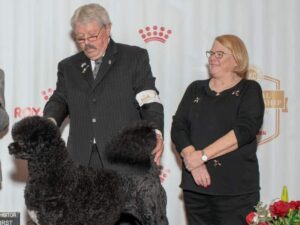
Marilu Novy & CJ Farve are breeders behind Overlook Lisiji Portuguese Water Dogs. Read about the kennel’s beginnings and much more!
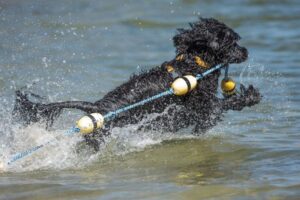
The water trial program offers challenges from the beginner to the most advanced level Portuguese Water Dog. Read more.

Cathy & Mike Dugan are the breeders behind Aviator Kennels Portuguese Water Dogs. Read about the kennel’s beginnings, champions, puppies.
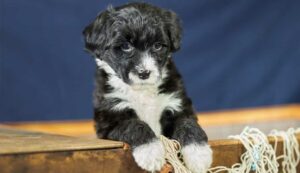
The following is a humorous (but pretty accurate) description of what an owner can actually expect from life with a Portuguese Water Dog.
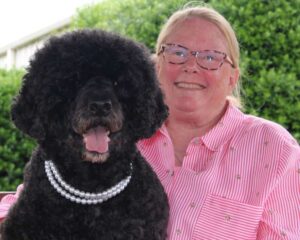
Interview with a Working Group Breeder Marilu Novy – Where do I live? How many years in dogs? How many years as a breeder?
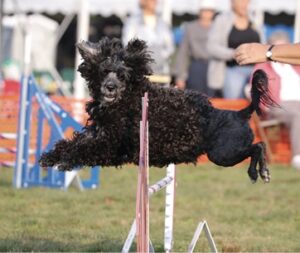
The Versatile Portuguese Water Dog | When you consider the breadth of work that the Portuguese Water Dog did for the Algarve fisherman
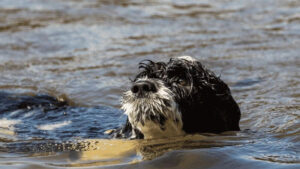
Discover the history of Portuguese Water Dogs, once vital for fishing. Explore their intelligence and versatility at PWDCA.org.
The best way to ensure a long and happy relationship with a purebred dog is to purchase one from a responsible breeder. Not sure where to begin?
Contact the National Parent Club’s Breeder Referral Program, which is listed on the AKC Breeder Referral Contacts page.
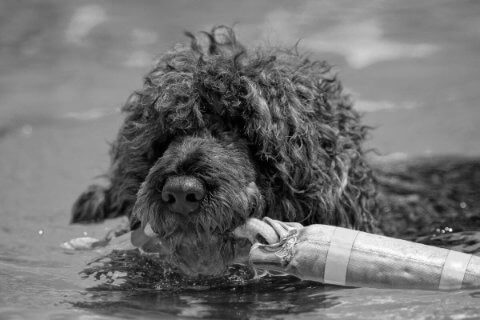

"*" indicates required fields
Showsight Magazine–the world’s most influential purebred dog publication since 1992. Each issue reaches a global audience dedicated to preserving the history and health of purpose bred dogs. Filled with award-winning editorial focused on news and insights from the dog show community, top breeders, handlers, AKC Judges, and more!